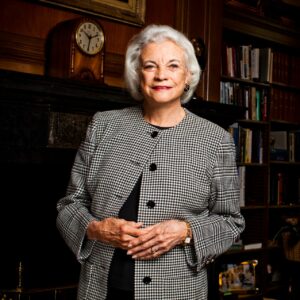Sandra Day O’Connor, First Woman on Supreme Court, Dies at 93
Originally published by Jess Bravin for the Wall Street Journal
Sandra Day O’Connor, the first woman appointed to the Supreme Court and its most powerful justice for much of her tenure, died Friday at age 93. O’Connor, who retired in 2006 after nearly 25 years on the court, died in Phoenix of complications related to advanced dementia and a respiratory illness, the court said in an announcement.
“A daughter of the American Southwest, Sandra Day O’Connor blazed an historic trail as our Nation’s first female Justice,” Chief Justice John Roberts said in a statement. “She met that challenge with undaunted determination, indisputable ability, and engaging candor.”
Justice O’Connor was an Arizona state judge in 1981 when Republican President Ronald Reagan, fulfilling a campaign pledge to break the male monopoly on the high court, selected her to succeed retired Justice Potter Stewart. She ushered in a wave of women marking “firsts” in the early 1980s, along with America’s first woman astronaut, Sally Ride, and first woman on a major-party presidential ticket, Geraldine Ferraro.
Over the next 24 years, Justice O’Connor came to wield the deciding vote between the court’s conservative and liberal wings. She displayed a knack for moderation and compromise that sat well with the broad American mainstream, even as it frustrated ideological purists.
Born March 26, 1930, in El Paso, Texas, and raised on her family’s Arizona ranch, the Lazy B, Sandra Day always considered herself a plain-spoken cowgirl rather than an intellectual theorist. But she was an exemplary student, entering Stanford University at age 16 and continuing to the Stanford Law School, graduating in 1952 alongside a future chief justice, William Rehnquist, whom she briefly dated.
While the corridors of power immediately opened for Rehnquist, who went to Washington as a law clerk for Justice Robert Jackson, O’Connor recalled that in an era when women lawyers were rare, she received just one job offer—as a secretary at the Los Angeles-based law firm Gibson Dunn & Crutcher.
After marrying a fellow Stanford law student, John O’Connor, the future justice eventually found work as a lawyer for the county attorney’s office in San Mateo, Calif.
The couple later settled in Phoenix and, along with raising three sons, Justice O’Connor became involved with Republican politics, working on Barry Goldwater’s unsuccessful 1964 presidential campaign. Beginning in 1969, she served in the Arizona state Senate, rising to majority leader. She was elected to the Maricopa County Superior Court in 1974, and elevated to the state Court of Appeals five years later.
Chief Justice Warren Burger met Justice O’Connor during a 1979 visit to Arizona, and became one of her principal advocates when Reagan was weighing his first Supreme Court appointment.
Confirmed unanimously by the Senate, Justice O’Connor immediately prompted changes in the formerly all-male institution; most obviously, the traditional courtesy title of “Mr. Justice” was dropped, in favor of “Justice” alone. Donning a leotard, she inaugurated an aerobics class for women law clerks.
The pragmatic jurisprudence that O’Connor championed, however, largely has been discarded by today’s far more conservative court, including several of her most significant opinions.
Although she had told Reagan she considered abortion “personally abhorrent,” she joined Justices Anthony Kennedy and David Souter to write the controlling opinion in Planned Parenthood v. Casey, a 1992 case that sought a middle ground by upholding several state restrictions on the procedure, while affirming the “essential holding” of Roe v. Wade, the 1973 decision recognizing a constitutional right to terminate pregnancy. The precedent survived until June 2022, when a more conservative court, overruling Casey along with Roe, rescinded the constitutional right to abortion.
Likewise, in 2003, when the court considered two separate affirmative-action programs at the University of Michigan, Justice O’Connor voted to strike down an undergraduate admissions formula for focusing too much on race, while writing the majority opinion upholding the law school’s more individualized consideration of race among an applicant’s other characteristics. That precedent fell in June, when the Supreme Court ruled that any consideration of race in college admissions violated the Constitution.
Justice O’Connor had strong views in some areas, and as a former state legislator believed that the Constitution imposed tighter limits on federal power than did her more liberal colleagues.
She was an incrementalist, however, who approached cases one at a time, rather than propounding a formalistic method of jurisprudence. That pragmatic view of judging often brought her into conflict with the second Reagan appointee, Justice Antonin Scalia, who derided one O’Connor opinion as so flawed that it “cannot be taken seriously.”
Justice O’Connor’s most controversial moment came during the election crisis of 2000, when the presidential race hung on the disputed outcome in Florida. As The Wall Street Journal reported at the time, Mr. O’Connor had remarked at an election night party that his wife wished to retire and would prefer that a Republican president select her successor. The following month, Justice O’Connor voted with the four other Republican-appointed justices to halt the Florida recount with GOP candidate George W. Bush ahead by 537 votes.
Later, she reflected that possibly the justices shouldn’t have accepted the case; the decision gave the court a “less than sterling reputation,” she noted.
